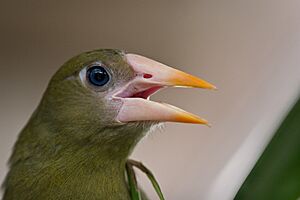Green oropendola facts for kids
Quick facts for kids Green oropendola |
|
|---|---|
 |
|
| Green Oropendola in Roraima - Brazil | |
| Conservation status | |
| Scientific classification | |
| Genus: |
Psarocolius
|
| Species: |
viridis
|
 |
|
The green oropendola (Psarocolius viridis) is a cool bird that lives in the Amazon basin and Guianas in South America. It's part of the Icteridae bird family. What makes it special is its pale beak with a bright orange tip – no other oropendola has this!
Male green oropendolas are bigger, weighing about 400 grams. Females are lighter, around 200 grams. Good news! This bird is quite common. Experts say it's a species of 'least concern', meaning it's not in danger.
What Do They Look Like?
Male green oropendolas grow to be about 43 centimeters (17 inches) long. Females are a bit smaller, around 37 centimeters (14.5 inches).
Their head, chest, and back are a light olive green color. Their wings are greyish-green. The lower back and belly are a warm chestnut brown. The middle feathers of their tail are black, but the outer ones are bright yellow!
Their beak has a unique orange tip. The base of the beak and the skin around it are yellowish. They have pale blue eyes. You might also spot a small crest (a tuft of feathers) on the back of their head.
Where Do They Live?
The green oropendola lives across a very large area in the tropical rainforests of South America. You can find them in many countries. These include Colombia, Venezuela, Guyana, Surinam, French Guiana, Brazil, Ecuador, Bolivia, and Peru.
How Do They Live?
Green oropendolas usually fly through the tops of the forest trees. They often join groups of different bird species. They eat both fruits and insects. By eating whole fruits, they help spread seeds around the forest. This helps new plants grow!
These birds sometimes follow small groups of red-throated caracaras. Caracaras are birds that hunt wasp nests. The oropendolas watch them for hours. They feed on their own, not necessarily eating the same things or at the same height in the trees.
Nests and Reproduction
Green oropendolas are social birds. They live in colonies and build amazing nests. Their nests are long and shaped like bags. They hang down from tree branches.
One male green oropendola will mate with several females. Sometimes, another bird called the giant cowbird will lay its eggs in the oropendola's nest. This is called 'brood parasitism'. The cowbird chicks are then raised by the oropendola parents.



